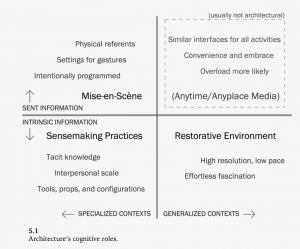Ambient Commons by Malcolm McCullough
While reading this Ambient Commons I bounced between thinking
- Cool this is someone who’s using data/being the environment without the digital detox meme to
- No, he just wants us to drop our phones to
- No, this really is a different take.
Upon finishing the book I settled on the idea that McCullough is advocating what I’ll call Slow Data, analogous to the Slow Food movement — data that you sample and savor to enrich your situated experience.
McCullough is a professor of architecture (architecture in the building/city planning sense, not in the data/software/computational sense) at the University of Michigan, so I was a bit surprised to see him building upon the situated cognition work I’ve discussed in some earlier posts e.g., Barrett and Clark
who he explicitly references). I think this is unusual (I’m not as current with the architecture literature as I would like to be), although I find it encouraging and somewhat expected — after all, if cognition is a situated experience, which in 2013 that usually means “situated in or near a building,” longstanding architectural desires to make buildings machines for living would require the thoughtful architect start to borrow ideas from situated cognition.
One aspect of the situated cognition movement is the study of how we build/use stable features of the environment to simplify and facilitate our lives, reducing the level of active thought needed to function. A simple example is putting your keys in the same place to avoid having to look for them/reconstruct your prior activities etc. later. Other examples, closer to “data” but rarely discussed, include how infrequently we change banks, dwellings, etc.. McCullough applies these principles to data, incorporating data in such a way as to structure your environment, and provide specific affordances to your desired experience.
The figure reproduced below is his way of structuring the environmental experience. Specific Information is specific to a particular environment and is created from specific environmental queues: either intrinsic to ourselves, our background knowledge, level of preparedness, etc., or Sent (transmitted by the environment to create an effect — literally “setting the stage” — his core example here is a courtroom). The generalized contexts are not specific to a particular environment, but are the tools we bring with us wherever we go (including our twitter feeds).
“The more enduring the environment, the more it shapes expectations without saturating attention” (58)
“Many of the most natural activities consist of mastering and configuring habitual contexts”(58)
McCullough’s claim is that by slowing down the data (to make it less distracting — but not so much viewing this in a negative sense, but in a positive one — slowing it and situating it, making it specific to a particular place), it becomes an affordance similar to a window looking out on a sunlit stone wall (one of his favorite examples).
“Consider a simple stone wall (figure 5.4). The texture of stone appeals to the eye. You could study it at length, or just keep it in background view all day. A seat with a view of this wall would be a better place to work all day at a laptop than a seat with only views of painted wallboard, or of textile-covered steel cubicles. Orientation would matter: the slow change of light through the day, or the slower change of the color of moss over the seasons, would improve the effect. More subtly, immediate orientation would suggest larger orientation within the” (74)
The sunlit stone wall is key example: it shows that the data need not be static, per se, but rather that the data should be habituatable so that we can tune it out, attending to it only when it is exceptional or explicitly desired. The stone & sun thing is of course not data oriented, per se, but one could imagine similar effects with other types of data, e.g., he mentions Seoul’s Living Light outdoor sculpture which maps air quality in real-time.
Situated data displays can allow for deeper discovery of your current environment, augmenting what’s available from the physical environment itself.
In concert with some of the quantified self movement it is easy to envision affordances that would provide feedback if you’ve been sitting too long, getting tense, getting fat, etc..
“Street computing doesn’t simply add a layer of portals to someplace else, but instead adds to cognition of the present place. It doesn’t command attention on one channel at a time, but instead interleaves media objects among themselves and with unmediated objects, and” (144)
“A similar process works for images, incidentally. One famous Layar app lets you see images of the Berlin Wall in the context where it once stood, as shown in figure 9.2.” (146)
Ambient commons, provide affordances for awareness and opportunities for increasing awareness when you are interested in doing so but don’t demand that you pay attention (he likens demands for attention to an unauthorized tax) to things that are not of interest but nonetheless hard to filter out — the paradigmatic example is the quick-moving, high contrast object at the edge of your field of vision. ambient commons are anti-ads, where ads want to grab your attention; the ambient commons allows you to pay attention only when you want to give it.
Designing a Commons of Ambient Information would be another description for the book. How do we create a common environment that maximizes the probability of adding to everyone’s experience, minimizes the attention tax on those who aren’t particularly interested, while providing greater opportunity for exploration when desired.
The trick is what data to surface and when: what should be on the personal device, what should be on the building wall in a dynamic display and what should be etched in stone. I think of the axes as involving Timeliness, Currency and Permanence.
Timeliness: information whose relevance has a strict, short temporal bound, centered on the NOW, e.g., if subway entrances had lights with a changing color scheme reflecting the expected arrival time of the next train (including ”black” for this line is undergoing repair).
Currency: the current air quality, network traffic, automobile traffic etc., low-resolution, more slowly changing data — The sense of the word resolution differs here from the way he’s using it in the book, when McCullough talks about resolution he’s talking about the quality of the display/interaction, e.g., a stone wall if very high res, but an air quality monitor is displaying air quality at low resolution since it is mapping a much larger physical space (the air surrounding the city) to a small physical space, e.g., a building.
Permanence may oddly apply to both the most and least virtual media: etched in stone is relatively permanent, but won’t tell the history of permanence at that location, e.g., the geology of the location since Precambrian times, available via an RFID tag queried by your phone.
His forward-looking and optimistic summation of the book also captures my feelings:
“Whatever the benefits of leading a well-focused life, as countless productivity and spiritual purpose guides would gladly help you do, there also benefits in dwelling well, through good design, and in taking notice of where you are. It is for broadening that particular circle of sensibilities that this inquiry has occurred.” (190)


Leave a Reply